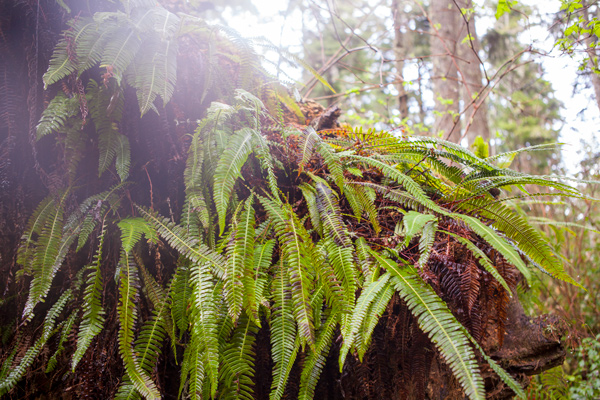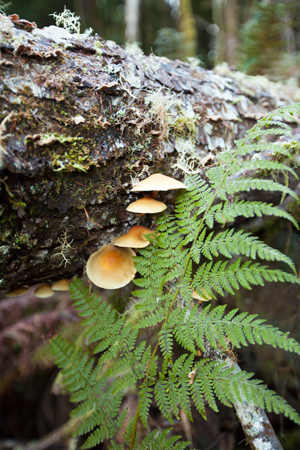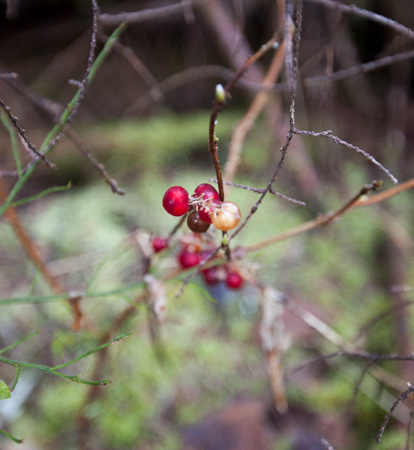At Fort Clatsop, Lewis prepares five new plant specimens and describes roots eaten by local Chinookan Peoples. The captains worry about the rate at which they are going through their supply of elk.
A Very Relaxed Day
by Yellowstone Public Radio[1]Originally aired weekdays by Yellowstone Public Radio during the Bicentennial observance of 2003-2006. Narrated by Hal Hansen. Scripts by Whit Hansen and Ed Jacobson. Produced by Leni Holliman. © … Continue reading
Five New Plant Specimens
Oregon Moss, Hypnum oreganum
Fort Clatsop National Historic Park
© 16 December 2010 by Jo Ann Townsend. All rights reserved.
Oregon Moss Specimen
Hypnum A Species of moss from Fort Clatsop. Jan: 20th 1806
—Meriwether Lewis[2]Hypnum oreganum. Moulton, ed. Herbarium, specimen 20.
Deer Fern, Blechnum spicant
Photo © 28 March 2012 by Kristopher K. Townsend. Permission to use granted under the Creative Commons Attribution-Share Alike 4.0 International license.
Deer Fern Specimen
Fort Clatsop. Jan: 20th 1806.
—Meriwether Lewis[3]Blechnum spicant. Moulton, ed. Herbarium, specimen 30.
Mountain Wood Fern, Dryopteris carthusiana
Fort Clatsop Fort-to-Sea Trail
© 21 January 2013 by Kristopher K. Townsend. Permission to use granted under the Creative Commons Attribution-Share Alike 4.0 International license.
Mountain Wood Fern Specimen
Polypodium Species. Fort Clatsop Jan: 20th 1806.
—Meriwether Lewis[4]Dryopteris carthusiana. Moulton, ed. Herbarium, specimen 58.
Salal, Gaultheria shallon
Fort Clatsop Fort-to-Sea Trail
© 21 January 2013 by Kristopher K. Townsend. Permission to use granted under the Creative Commons Attribution-Share Alike 4.0 International license.
Salal Specimen
The Shallon; Supposed to be a Species of Vaccinium. On the Coast of the Pacific Ocean. Jan: 20th 1806
—Meriwether Lewis[5]Gaultheria shallon. Moulton, ed. Herbarium, specimen 74.
Red Huckleberry, Vaccinium parvifolium
Fort Clatsop Fort-to-Sea Trail
© 21 January 2013 by Kristopher K. Townsend. Permission to use granted under the Creative Commons Attribution-Share Alike 4.0 International license.
Red Huckleberry Specimen
New Species. With a purple Small berry eatable, an evergreen Fort Clatsop Jan 20th 1806.
—Meriwether Lewis[6]Vaccinium parvifolium. Moulton, ed. Herbarium, specimen 172.
Disappearing Elk Meat
on the morning of the eighteenth we issued 6 lbs. of jirked Elk pr. man, this evening the Sergt. repoted that it was all exhausted; the six lbs. have therefore lasted two days and a half only. at this rate our seven Elk will last us only 3 days longer, yet no one seems much concerned about the state of the stores
—Meriwether Lewis
The Hunters’ Skills
our skill as hunters afford us some consolation, for if there is any game of any discription in our neighbourhood we can track it up and kill it. most of the party have become very expert with the rifle.
—Meriwether Lewis
Chinookan Vegetables
The native roots which furnish a considerable proportion of the subsistence of the indians in our neighbourhood are those of a species of Thistle [Edible Thistle], fern [Western Bracken Fern] and rush; [Giant Horsetail] the Liquorice [seashore lupine], and a small celindric root [unidientified] the top of which I have not yet seen, this last resembles the sweet pittatoe very much in it’s flavor and consistency.
—Meriwether Lewis
Dried Salmon Trade
The Indians who visited us today understood us sufficiently to inform us that the whites did not barter for the pounded fish; that it was purchased and consumed by the Clatsops, Chinnooks [Chinooks], Cathlahmah’s [Kathlamets] and Skillutes [Skilloots].
—William Clark
Weather Diary
aspect of the weather at rise
Wind at rise
Weather at 4 OC. P.M. Wind at 4 OC. P.M. rain after rain S. W rain after rain S W raind greater part of night wind hard
—Meriwether Lewis[7]To assist the reader, the editor of this web page has omitted the “Day of the month” column and spelled out some abbreviations.
Experience the Lewis and Clark Trail
The Lewis and Clark Trail Experience—our sister site at lewisandclark.travel—connects the world to people and places on the Lewis and Clark Trail.
Plan a trip related to January 20, 1806:

Fort Clatsop is a High Potential Historic Site along the Lewis and Clark National Historic Trail managed by the U.S. National Park Service. The site is managed by the Lewis and Clark National and State Historic Parks.
Notes
| ↑1 | Originally aired weekdays by Yellowstone Public Radio during the Bicentennial observance of 2003-2006. Narrated by Hal Hansen. Scripts by Whit Hansen and Ed Jacobson. Produced by Leni Holliman. © 2003 by Yellowstone Public Radio. |
|---|---|
| ↑2 | Hypnum oreganum. Moulton, ed. Herbarium, specimen 20. |
| ↑3 | Blechnum spicant. Moulton, ed. Herbarium, specimen 30. |
| ↑4 | Dryopteris carthusiana. Moulton, ed. Herbarium, specimen 58. |
| ↑5 | Gaultheria shallon. Moulton, ed. Herbarium, specimen 74. |
| ↑6 | Vaccinium parvifolium. Moulton, ed. Herbarium, specimen 172. |
| ↑7 | To assist the reader, the editor of this web page has omitted the “Day of the month” column and spelled out some abbreviations. |







